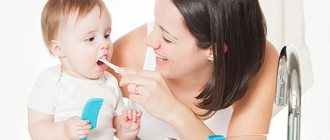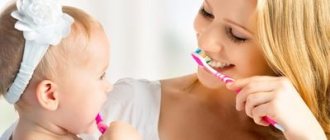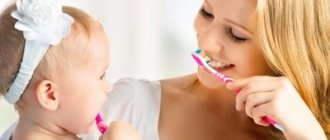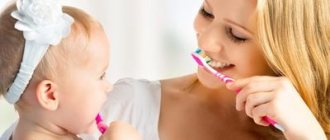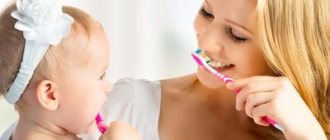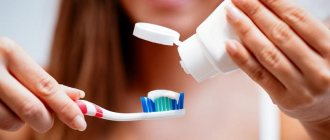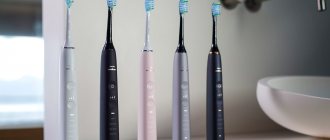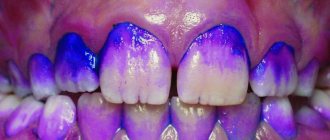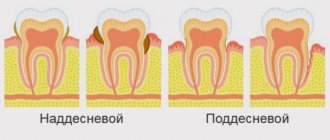The health of the dentition and gum tissue depends on many factors, the key of which is the quality of hygiene procedures.
Regular removal of bacterial plaque and food residues allows you to maintain the natural microflora of the oral cavity and prevents the development and proliferation of pathogenic microorganisms.
At the same time, hygiene procedures must be not only timely, but also correct, and for this it is important to understand exactly how each of the devices intended for cleaning the dental surface should be used.
Using a classic toothbrush
Cleaning with a manual brush should be carried out at least twice a day - in the morning and in the evening (before bedtime). The recommended duration for processing a row using this device is 3-4 minutes.
Scheme for cleaning the upper and lower dentition with a classic toothbrush
Proper cleaning with a classic brush involves the following steps:
- A pea of paste is applied to a brush moistened with water.
- Cleaning begins from the upper jaw. You need to start with the front teeth, gradually moving towards the molars.
- Movements to remove plaque should be sweeping and directed from the gum line to the cutting surface.
- To clean the cutting surface of the teeth, the brush is positioned perpendicular to it, after which circular movements are performed.
- After performing manipulations with the upper row, the same procedure is repeated with the elements of the lower jaw.
- To complete the hygiene procedures, it is necessary to clean the tongue using bristles or the back of the brush head if it is equipped with a rubber grooved surface.
After thoroughly removing plaque with a brush, you can rinse your mouth with a special rinse, which not only helps improve the condition of your teeth and gums, but also ensures fresh breath for a long time.
The video provides a detailed description of using a toothbrush.
What is a wedge-shaped tooth defect and the reasons for its development. Read here all the most interesting things about decorating teeth with rhinestones.
At this address https://dr-zubov.ru/ortopediya/semnye-protezy/kak-osushhestvlyaetsya-remont.html we will tell you whether it is possible to repair a removable denture.
Electrical devices
The technology of brushing teeth with an electric brush is slightly different from the manipulations carried out with a classic device.
This is due to the absence of the need to exert additional force, since the brush head makes pulsating and rotating movements, removing plaque.
Manufacturers of electric brushes include the following instructions for use with their products:
- The brush head is moistened with water, after which a small ball of paste is applied to it.
- The brush is placed near the front teeth parallel to the jaw line, after which the power button is pressed.
- The duration of cleaning one unit should not exceed 4-5 seconds. In this case, you should not apply pressure or make horizontal or circular movements.
- Moving from the central incisors to the molars, the front surface of all elements of the upper and lower jaw is cleaned.
- To remove plaque from the lingual and cutting parts of the row, the brush is positioned vertically, after which the procedure is repeated.
After completing the process of brushing your teeth, the same procedure is carried out with your gums, however, this is permissible in the absence of inflammatory processes in them.
Watch the video for instructions on brushing your teeth with an electric brush.
Popular questions and answers
Proper brushing of teeth is the basis for the prevention of all oral diseases. And how to maintain it at the proper level, what nuances to pay attention to, dental surgeon, implantologist, periodontist Ekaterina Dronova will tell you.
Why is it so important to follow the rules of brushing your teeth?
It’s not enough just to have the most expensive, advertised toothbrush and toothpaste; it’s important to know the technique of brushing your teeth and understand the end result. Teeth cleaning involves removing soft plaque from the buccal, lingual, palatal, chewing, and contact (between teeth) surfaces. And this is only possible with the right technique.
How to improve the quality of teeth cleaning?
Exclusively under the supervision of a dentist as part of a supervised teeth cleaning procedure.
It consists of professional monitoring using modern plaque diagnostic methods: solutions or tablets for plaque detection. As part of the procedure, the dentist invites the patient to brush their teeth as they usually do at home. Afterwards, the patient is asked to rinse the mouth with a special solution or dissolve a tablet that colors the plaque: soft in one color, stone in another, darker color. This clearly shows problem areas that need to be addressed in the future. By the way, such plaque indicators can and should be used at home. Especially for patients at risk: • with crowded teeth; • bite pathologies, when one or more teeth extend beyond the dentition; • during orthodontic treatment, when braces or other structures are installed in the oral cavity.
In this case, it is important to convey to the patient recommendations on oral hygiene, especially the use of brushes, dental floss, irrigators, rinses, etc.
Are there any particularities in brushing teeth when implants are installed and during the stages of treatment?
Understanding by patients the importance of good oral hygiene during implant installation is the path to success, as well as reducing the risks of post-implantation complications.
Before installing implants during consultation, all risks are assessed: • presence of bad habits, for example, smoking; • level of hygiene; • patients always undergo comprehensive professional oral hygiene first; • the patient's desire to achieve goals and change the condition of the oral cavity for the better.
In general, the rules of hygiene during implant treatment are the same, but there are some peculiarities: the use of soft brushes, anti-inflammatory toothpastes, antiseptic rinses, etc. Each specific clinical case has its own set of hygiene recommendations.
Cleaners
Brushes for cleaning teeth are used as an additional device for oral hygiene.
A properly selected product helps remove plaque from hard-to-reach areas of the jaw, for example, the interdental space.
To remove bacterial plaque using a brush, you must perform the following sequence of actions:
- The brush is brought to the space between the molars and carefully inserted into it at an angle of 90 degrees until the tip of the product appears from the inside.
- Several careful back-and-forth movements are performed in the interdental space.
- The brush is removed from the treated slot and washed under running water.
- The manipulation is repeated with each element of the upper and lower jaw rows.
When using a brush, it is important to understand that its insertion should not cause pain or discomfort.
Otherwise, you should contact your dentist for advice and help in choosing the appropriate size of the device.
In the video, watch the cleaning technique with a brush.
Irrigator
The use of an irrigator allows you to efficiently remove plaque from the gum pockets and interdental space, even with maximum crowding of incisors and molars.
To do this, you must follow the sequence of actions:
- An individual nozzle is installed in a special connector of the irrigator.
- The reservoir is filled with water at a temperature comfortable for the oral cavity or with a special rinse aid.
- If the device has several operating modes, the most suitable one is selected, taking into account the condition of the oral cavity.
- Teeth cleaning begins with the far molars. The device is positioned in the oral cavity so that the nozzle is directed at a right angle to the tooth, after which the power button is pressed.
- The space is treated in the following sequence: first the interdental space, then the gum line, then the rest of the molar. This manipulation is repeated with all elements of both jaws.
- After finishing using the irrigator, it must be turned off and the reservoir must be rinsed if a mouth rinse solution was poured into it.
Do not forget that while using the irrigator, water will flow out of the oral cavity, so the procedure must be performed in front of the sink.
Find out how to use the irrigator from the video.
Teeth whitening technique with activated carbon and effective recipes. Learn about the symptoms of oral cancer in this article.
Follow the link https://dr-zubov.ru/lechenie/bolezni-polosti-rta/gel-kamistad-instrukciya-po-primeneniyu.html if you are interested in instructions for using Kamistad ointment.
Clinical researches
Clinical studies have proven that regular use of professional toothpaste ASEPTA REMINERALIZATION improved the condition of the enamel by 64% and reduced tooth sensitivity by 66% after just 4 weeks.
Sources:
- Report on the determination/confirmation of the preventive properties of personal oral hygiene products “ASEPTA PLUS” Remineralization doctor-researcher A.A. Leontyev, head Department of Preventive Dentistry, Doctor of Medical Sciences, Professor S.B. Ulitovsky First St. Petersburg State Medical University named after. acad. I.P. Pavlova, Department of Preventive Dentistry
- Evaluation of the clinical effectiveness of a combined drug of local etiotropic action in the treatment of inflammatory periodontal diseases (E.L. Kalichkina, E.A. Tyo, Z.Z. Abubakarova) E.L. Kalichkina, candidate of medical sciences, assistant of the department of therapeutic dentistry, Kemerovo State Medical Academy of Roszdrav, Kemerovo E.A. Tyo, MD, professor, head of the department of therapeutic dentistry, Kemerovo State Medical Academy of Roszdrav, Kemerovo Abubakarova, assistant of the department of therapeutic dentistry, Kemerovo State Medical Academy of Roszdrav, Kemerovo GOU HPE Kemerovo State Medical Academy of Roszdrav , Kemerovo
- Clinical and laboratory assessment of the influence of domestic therapeutic and prophylactic toothpaste based on plant extracts on the condition of the oral cavity in patients with simple marginal gingivitis. Doctor of Medical Sciences, Professor Elovikova T.M.1, Candidate of Chemical Sciences, Associate Professor Ermishina E.Yu. 2, Doctor of Technical Sciences Associate Professor Belokonova N.A. 2 Department of Therapeutic Dentistry USMU1, Department of General Chemistry USMU2
Ionic devices
The operating principle of the ionic brush is based not only on mechanical action, but also on changing the polarity of the teeth, due to which plaque is more effectively separated from the enamel.
The technology for cleaning the jaw row using this product is as follows:
- The hygienic procedure begins with the removal of plaque located on the surface of the tongue. Using gentle massage movements, you need to move from its base to the tip.
- The same delicate movements remove plaque from the gums and mucous membrane of the cheeks.
- Next, the brush is thoroughly rinsed under running water, after which a small amount of paste is applied to it.
- The procedure for cleaning the teeth is no different from those manipulations that are usually carried out when using a manual brush, with the difference that the intensity of movements may be lower.
To increase the effectiveness of using the brush, approximately once a month it is necessary to remove the attachment and clean the metal core.
In the video, a specialist explains how to use ionic toothbrushes correctly.
Choosing toothpaste
To brush your teeth properly, you need to take a responsible approach to choosing toothpaste. It is necessary to select a product taking into account the condition of the oral cavity. Not all products are suitable for sensitive teeth. For people who suffer from rapid plaque formation, an antibacterial paste will be needed. Those who have increased gum bleeding will need to purchase a special medicated paste. To make the cleansing process comfortable and effective, it is better to give preference to products from well-known brands that have long proven themselves in the market. Before you buy a whitening paste, you need to know that such products mainly contain special enzymes that quickly remove plaque. Dentists do not recommend using whitening pastes for more than two months.
You should remember a simple rule: too much product reduces the effect of brushing. For one procedure, a pea-sized amount of paste should be enough.
Mono-beam products
A mono-beam brush can be used not only by users of orthodontic structures, but also by everyone for the daily removal of plaque from the elements of the jaw row and gum pockets.
In order for the device to bring maximum benefit, when using it, you must adhere to the following sequence of operations:
- The head of the product is moistened with water, after which it is positioned at an angle of 45 degrees relative to the surface to be processed. It is advisable to start with the outermost molars, moving towards the central incisors.
- First, you need to clean the gum line, then treat the periodontal pocket and the remaining surface of the tooth, moving from the base to the cutting part. Movements should be sweeping or circular.
- After cleaning the front part of the tooth, the lingual part, the cutting surface and the space between adjacent molars are treated in the same way.
- The manipulations are repeated with each element of the jaw row. The duration of treatment of one tooth should not be less than 10 seconds.
The technique of cleaning with a mono-beam brush is presented in the video.
How to properly brush your teeth with toothpicks?
Doctors do not recommend frequent use of toothpicks, as they can injure the gums. However, if you don’t have floss on hand, you can carefully use a toothpick, following these recommendations:
- Do not use force when cleaning the interdental space from food particles;
- Do not make sudden movements;
- Try to maintain a 45-degree angle when using a toothpick;
- The direction of movement should be from the gum to the sharp edge of the tooth;
- It is recommended to apply only light pressure so that the toothpick does not break during the process.
Flosses
Dental floss allows you to remove plaque and the smallest food debris from the minimal interdental space, which cannot be penetrated with a brush.
To achieve maximum results and prevent gum injury, you should follow these recommendations:
- With thoroughly washed and dried hands, remove about 30 cm of thread from the container and cut it using the built-in knife.
- The floss is wound around the index fingers of both hands so that the length of its free part does not exceed 5 cm.
- A section of floss formed between the fingers is inserted into the interdental space up to the gum line and gently lowered into the pocket, surrounding the neck of the tooth.
- With smooth sweeping movements, plaque is removed from under the gums, after which the thread is lifted with longitudinal movements to the cutting part.
- The used piece of thread is replaced with a new one, after which the manipulations are repeated in the next interdental space.
When flossing, it is important to use smooth movements to avoid accidental injury to the gum tissue.
Watch the video on how to use interdental floss.
Technology using thread (floss)
Dental floss is used to remove food debris and plaque in places where it is difficult for a standard brush to penetrate. Usually this is the interdental space, the distance between the orthodontic system, and the cervical area.
Before using this thread, you should correctly decide on its choice. Two types of floss are used for teeth:
- Nylon . Suitable for crowns with standard or wide interdental spaces. Removes plaque well.
- Teflon . Thinner than the first option, therefore it is recommended for people with a small gap between the crowns.
Floss will have a good effect only if used correctly:
- For cleaning you will need about 35 cm of thread. Measure it from the main coil and tear it off;
- wrap the ends of the thread around your index fingers;
- adjusting the tension of the floss with your thumbs, carefully pass it between the crowns;
- moving the thread up and down, clean the adjacent surfaces;
- after this, floss in the cervical area, covering the area under the gum;
- remove the floss by alternately pulling back and forth, while lifting;
- In the same way, carry out the procedure to remove deposits on the remaining teeth, using an untouched section of the floss. During this process, avoid sudden movements and excessive force to avoid cutting the gum tissue.
Below is a video with dentist tips on using floss:
Secrets of caring for braces
In order to efficiently clean the teeth and the space between the elements of the orthodontic structure, dentists recommend using not a regular brush, but a product with a V-shaped bristle or a mono-tuft model.
The procedure for removing plaque is also slightly different from regular cleaning:
- The brush is positioned at an angle of 45 degrees relative to the front surface of the tooth.
- With the help of forward and backward movements and slight pressure on the brush, the enamel is cleaned of the plaque covering it, both from the outside and from the inside.
- To clean the bracket, you need to perform a few light movements from the gum line to the cutting surface of the tooth and in the opposite direction. Strong pressure should be avoided to avoid damaging the locks.
- The cutting surface is cleaned by placing the brush perpendicular to the axis of the jaw row elements. Circular movements of the bristles, combined with slight pressure, will qualitatively remove small particles of food and pathogenic microflora.
To effectively remove plaque, dentists recommend working on each element of the row for at least 10 seconds.
Learn about hygiene with braces from the video.
What mistakes when brushing your teeth can cause tooth decay?
Here are a few common mistakes8 Bad Brushing Habits to Break in 2022 / MouthHealthy / American Dental Association that make brushing at best ineffective, and at worst a useless and even harmful activity.
You use the same toothbrush for more than 3–4 months
Worn and broken bristles cannot effectively remove plaque from teeth. The American Dental Association (ADA) recommends replacing your toothbrush with a new one every quarter.
You press too hard on the brush when brushing
You may feel like scrubbing harder will remove more bacteria and food debris. But that's not true. To properly “wash” the surface of the tooth, careful and even gentle movements are enough. But excessive assertiveness can damage the gums and even tooth enamel.
For the same reason, you should not use a brush with too stiff bristles.
You brush your teeth immediately after eating
Dentists recommend waiting at least 60 minutes. This is especially important if you have eaten something sour (for example, lemons, grapefruits) or drank soda. These products soften tooth enamel and brushing may be harmful.
If you're desperate to freshen your mouth immediately after eating, rinse it with water or chew gum.
You are storing your brush incorrectly
You should not keep the brush in a closed container: microbes actively multiply in such places, which you then carry into your mouth directly on the bristles. The best way to store your brush is in an upright position outdoors.
You do not follow proper teeth brushing technique
It is important to thoroughly and thoughtfully clean all dental surfaces, not just those that are easiest to reach. Remember why you are brushing your teeth. This procedure is not for show, its purpose is to keep teeth healthy and protect them from caries. So use your brush carefully.
Orthopedic structures
After installation of a fixed orthopedic structure, close attention must be paid to oral hygiene.
This is explained by the fact that food debris and soft bacterial plaque can accumulate in the cervical area, which over time will lead to gum inflammation.
Dentists give the following recommendations for caring for fixed orthopedic structures:
- hygiene procedures must be performed at least twice a day;
- brush movements should be sweeping and directed from the gums to the cutting part of the bone organs;
- after each meal, you must thoroughly rinse your mouth with water or special solutions;
- In addition to the brush, you should use an irrigator that allows you to remove plaque from minimal spaces using the pressure of a water jet.
You should also not forget about regular visits to the dental office for professional cleaning of orthopedic structures and your own teeth.
In the video, the dentist will talk about effective care for orthopedic structures.
How do plaque tablets work?
We usually contact a dentist to assess the quality of oral hygiene. It identifies areas that are not cleaned effectively and makes recommendations for replacing the paste or brush. But in between visits to the clinic, you can cope without the help of a doctor.
Special tablets, developed by the Swiss company CURADEN, will help with this. They are part of the CURAPROX range of dental care products. Determination of plaque occurs as follows: • the tablet is diluted in water; • after brushing, a person rinses his mouth with this solution, distributing it over his teeth; • deposits are stained, clean enamel remains intact.
The tablets also help distinguish soft plaque from tartar. The first one becomes pink, the second one becomes dark blue. This way you can understand whether it’s time to go for ultrasonic cleaning.
Errors allowed
Dentists who are faced with various diseases of the teeth and gums note that in some cases the problems are caused by non-compliance with the rules of hygiene procedures.
Most often, patients make the following mistakes:
- Cleaning time for jaw row elements is too short . This action leads to insufficient quality of plaque removal, which can result in the development of caries and numerous gum inflammations.
- Wrong choice of brush. Products with overly soft bristles will not be able to effectively remove all plaque from the enamel. If the fibers are too hard, you can damage the surface, making it too sensitive.
- Horizontal movements . Making incorrect movements with a brush can not only reduce the effectiveness of removing deposits, but also damage the enamel in the neck of the tooth, which entails the development of a wedge-shaped defect.
- Fast aggressive cleaning . Performing sudden movements can lead to accidental injury to the gums, causing them to bleed and become inflamed.
- Untimely replacement of the brush . The oral cavity cleaning product needs to be replaced every two months, as harmful microorganisms can accumulate and develop in the bristles over time. Using such a brush will lead to an inflammatory process in the oral cavity.
Find out what mistakes are made during oral hygiene from the video.
Care products - paste selection
In general, the action of the cleaning mixture is aimed at solving two problems: disinfection and enhancing the mechanical work of the brush. To achieve maximum efficiency, foaming agents and abrasives are added to the composition. Such particles intensively polish the enamel, eliminating harmful microorganisms.
When choosing from the abundance of products presented by manufacturers, it is first necessary to take into account individual oral problems. If the gums are inflamed, the presence of abrasive components should be discarded. The best option in this case would be therapeutic and prophylactic formulations. They have a pronounced anti-inflammatory effect. In case of increased sensitivity, preference should be given to those brands that contain strontium or potassium chloride.
While watching a video on how to properly brush your teeth with a regular toothbrush, don’t forget that just because you don’t have any dental problems yet doesn’t mean they can’t appear in the future. There is always a risk. For preventive purposes against periodontitis and caries, it is necessary to use a paste with useful components: herbal extracts, seaweed extracts, fluoride. These components prevent the occurrence of diseases in the oral cavity. However, you should not use exclusively fluorine-containing compounds. It is better to alternate them with other types of cleaning products.
Optimal quantity
When cleaning, squeeze out a strip approximately 5 mm long onto the brush. A small piece is enough to carry out a full procedure and provide effective protection. There is no need to increase the rate, especially when it comes to abrasive compounds. Otherwise, the enamel layer may be severely depleted, which will lead to problems.
How to teach a child
The need to brush children's teeth arises immediately after the first elements of the series erupt. For children under two years of age, this responsibility falls on the parents.
To remove plaque from baby teeth, use a cotton pad or gauze pad moistened with water, which is gently wiped over the incisors after each feeding.
From the age of two, children can take care of their teeth themselves. In order for the process to interest the baby and give him pleasure, it is necessary to carefully choose a brush.
The product may have an interesting design, but the main thing is that its bristles are soft and made of synthetic material.
The procedure for children under six years of age should consist of the following manipulations:
- The brush is wetted in water, and a small ball of paste is applied to it.
- With the jaws closed, the front surface of the dentition is cleaned. To do this, make careful circular movements.
- The back surface is also cleaned using circular movements.
- To remove plaque from the cutting part, it is necessary to perform horizontal movements with a brush.
- The duration of cleaning the jaw rows should be 2-3 minutes.
To instill in their child the habit of brushing their teeth every day, parents must set the right example by doing this procedure with their child.
If the child does not show particular interest in the process, it is worth presenting this need in the form of a game process.
The procedure for brushing teeth for children over six years of age is no different from the sequence of manipulations performed by adults.
The video explains in detail how to teach children to brush their teeth.
Teaching correct methods to children
Cleaning children's teeth often causes a lot of problems. Before starting this activity, the child needs to be interested or motivated . As a rule, imagining the cleaning process in the form of a game gives a good effect.
But even if the child is happy to do this procedure, it is worth monitoring the correct execution of all actions. How should children brush their teeth?
This question can only be answered by conditionally dividing them into two groups:
- Children under one year old .
This category of children, just like adults, needs to clean their emerging teeth. Already from the appearance of the first teeth, it is worthwhile to regularly clean them. To do this, after each feeding, wipe the surface of the teeth with a clean napkin or cotton pad moistened with boiled water. - Children after one year .
For this category, this procedure does not differ from the standard process of brushing teeth for adults. The only difference is the paste and brush used: up to three years, the brush must be soft and not cover more than two crowns, and the paste cannot contain fluoride. After this age, when using such products, you must adhere to the dentist’s recommendations.
The entire cleansing process should be carried out under the supervision of an adult and not exceed 3 minutes, since the enamel in children is too weak.
Proper brushing of teeth is considered an insignificant process. But practice shows that compliance with the necessary technique is an important factor in preventing dental diseases.
Well, the following video will help teach your child how to brush their teeth correctly:
If you find an error, please select a piece of text and press Ctrl+Enter.
Tags braces video dental floss toothbrushes irrigators monobeam toothbrushes ultrasonic toothbrushes teeth cleaning electric toothbrushes
Did you like the article? stay tuned

